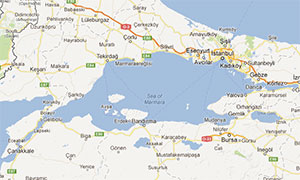Haydarpasa TCDD
OPERATED BY: General Directorate of Turkish Sate Railways (TCDD)
ADDRESS: TCDD Liman Isletmesi Mudurlugu Haydarpasa/Istanbul - Turkey
PHONE: (0216) 337 99 88 - 336 94 45 - 348 80 20
FAX: (0216) 345 17 05
LOCATION: 40° 59' 00" N, 28° 57' 00" E
The port of Haydarpasa is situated on the Anatolian side of Bosphours in Istanbul. The port serves a
hinterland which is the most industrialized area of Turkiye. It has a great importance being a gateway to
the world as the biggest container port In Marmara Region The port has two breakwaters so as to protect
the vessels form all kinds of effects caused by the sea.
ANCHORAGE AREAS: please see "Anchorage Areas" in Turkish Straits & Istanbul region (Information on best location of anchorage will be given by Pilot station).
PILOTAGE: : is compulsory for berthing and unberthing and anchoring, provided by the Turkish Maritime Organization.(TDI) .VHF channels 14, 16. Pilots meet vessels West of a line passing through the light on the breakwater of Kumkapi Fishing Boat Harbour.
TOWAGE: and/or mooring boat compulsory arranged by pilot and and provided by the Port Administration (TCDD). VHF channels 12, 16.
BERTHING
BERTH NO BERTH GROUP LENGTH(m) DEPTH(m)
1 Motor boat servicing 150 -2 –4,5
2-3 General Cargo/Dry Bulk 430 -5 –9.5
4-5 General Cargo 334 -9 -9.5
6 General Cargo 220 -9.25
7-8 General Cargo 246 -9
9 General Carg 206.5 -7
10-11 Container 350 -7 –10
12A – 12B Container 300 -10
13-14 Container 295 -7.5 – 8
15 General Cargo 220 -7
16 General Cargo 160 -6
17 Ro-Ro 141 -7
18 Ro-Ro 164 -7
19 General Cargo/Passenger (*) 97 -6
20 General Cargo/Passenger (*) 50 -6
21 General Cargo/Passenger (*) 50 -6
(*) There are plans for passenger vessels facilities
CARGO HANDLING EQUIPMENTS: The floating crafts comprise 1 floating crane of 250 tons cap. 17 shore and yard cranes of 3 to 35 tons capacity, 17 mobile cranes 5 to 25 tons capacity, 67 general cargo forklifts of 2 to 5 tons capacity, 1 loader, 6 tractors, 25 trailers of 40 tons capacity, 10 trailers of 20 tons capacity, weigh-bridges 2x100 tons. 2 rail ferries.
STORAGE: Open storage areas 313.047 sq.m. and covered areas 21.043 sq.m and one container stacking areas 50.000 sq.m outside the port for stacking the empty containers.
CONTAINER HANDLING FACILITIES: 4 container quayside gantry cranes of 35 tons capacity, 16 reach stackers of 40 -42 tons capacity, 9 transtainers of 40 tons capacity, 20 container forklifts of 8 -40 tons capacity, 31 tug masters. The space for container terminal is nearly 100.000 sqm. The holding capacity of the container terminal is 6.000 TEU (both full and empty). The annual capacity, on the other hand is 144.000 TEU/year.There are two areas hired outside the port for stacking the empty containers. A container freight station of 3.600 sq.m. is available behind the container quay. Another facility available at the port is the provision of reefer facilities for refrigerated containers.
RO-RO FACILITIES: Newly built modern ro-ro terminals is in service. The ro-Ro terminals can accommodate 360 ships per year, and can handle 410.000 tons/year of ro-ro cargo, 65.000 trucks (incoming-outgoing), and 60.000 cars/year.There are daily Ro-ro services between Haydarpasa and Trieste and Constanza ports.
BULK HANDLING FACILITIES: TMO Berths no: 2 and 3 serves the dry bulk traffic. A grain silo of 70.000 tons capacity is available and has a conveyor connection with the quay.
OTHER INFORMATIONS: A computer aided system for port operations has already been set up.
DENSITY: 1014-1016 always variable due to strong currents.
FRESH WATER: available on the berths or by barge.
BUNKER: available by barge or trucks.
AIRPORT: At Istanbul distance apprx. 30 km and 25 km to Sabiha Gokcen Airport from the port.
WORKING HOURS: operates 24 hours a day year round,
Administrative: 08.00-17.30hrs.
First Shift: 08.00-16.30hrs.
Second Shift: 16.30-00.30hrs.
Third Shift: 00.30-08.00hrs.
GARBAGE REMOVAL: service is available.
WASTE OIL DISPOSAL: An oil-water separator system available at the capacity of 10.500 cu.m/year to clean bilge water in conformity with the IMO regulations.
More Ports
-

Akcansa Canakkale
-

Aksa
-

Aktas
-

Alemdar Dilovasi
-

Altintel Dilovasi
-

Ambarli Istanbul
-

Aslan Cement Darica
-

Aygaz LPG Yarimca
-

Bagfas Bandirma
-

Bandirma TCDD
-

Borusan Gemlik
-

Botas Marmara Ereglisi
-

BP Gemlik
-

Camar Izmit
-

Canakkale TDI
-

Cekisan Terminals
-

Derince TCDD
-

Diler Hereke
-

Dolphin Gemlik
-

Elyaf Factory Pier Yalova
-

Gemlik Municipality
-

Gemport
-

Igsas Izmit
-

Kizilkaya Dilovasi
-

Kroman
-

Limas Pursan Izmit
-

Mardas
-

Marmara Island
-

Marmara Yarimca
-

Martas Marmara Ereglisi
-

Mollasses Terminal Yarimca
-

Mudanya Municipality
-

Petkim Yarimca
-

Petrol Ofisi Pier
-

Poliport Dilovasi
-

Rota
-

Sedef Dilovasi
-

Solventas Terminal Dilovasi
-

Tekirdag
-

Total Gebze
-

Tugsas Gemlik
-

Tupras Tutunciftlik Izmit
-

Tuzla Istanbul
